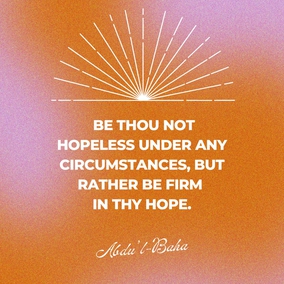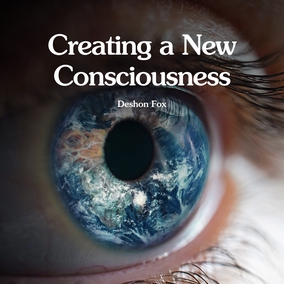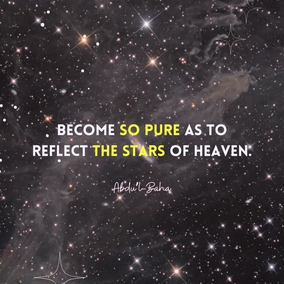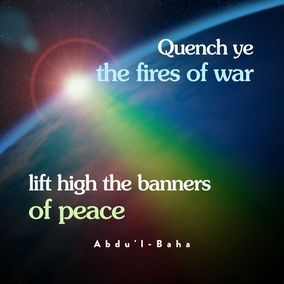The views expressed in our content reflect individual perspectives and do not represent the authoritative views of the Baha'i Faith.
The essential teachings of all the great Faiths, the Baha’i teachings affirm, are in harmony.
As a demonstration of that fact, I shared these eerily similar scriptural passages with my online friend Jesse as a demonstration of the common threads of religious revelations:
There the sun shines not, nor the moon gives light, nor the fire burns, for the Light of My Glory is there. Those who reach that abode return no more. — Krishna, Bhagavad Gita 15:6
The sun shall no longer be your light by day, Nor for brightness shall the moon give light to you; But the Lord will be to you an everlasting light, And your God your glory.— Old Testament Book of Isaiah 60:19
By day shines the sun; by night, the moon… But all day and all night, every day and every night, the Awakened One shines in splendor. — Gautama Buddha, Dhammapada vs 387 (describing the state of the inhabitant of Nirvana)
The city does not need the sun or the moon to shine on it, for the Glory of God gives it light and the Lamb is its lamp. The nations will walk by its light, and the kings of the earth will bring their splendor to it. — Christ Spirit, Revelation of St. John 21:23-24
That city is none other than the Word of God revealed in every age and dispensation. In the days of Moses it was the Pentateuch; in the days of Jesus the Gospel; in the days of Muhammad the Messenger of God the Qur’an; in this day the Bayan; and in the dispensation of Him Whom God will make manifest His own Book—the Book unto which all the Books of former Dispensations must needs be referred, the Book which standeth amongst them all transcendent and supreme. —Baha’u’llah, The Book of Certitude
My friend replied that this was further evidence of syncretism — meaning that he thought Baha’u’llah had selected his teachings from a smorgasbord of prior and equally syncretistic faiths.
RELATED: 4 Ways to Understand the Relationship of the Prophets
Jesse believed that Christianity was also syncretistic and that Jesus of Nazareth was fictional. If there’d really been an actual Jesus, he said, his followers would have written down everything he did immediately in exhaustive detail. He claimed that a group of men (notably the Apostle Paul) had constructed the Christian Faith from Jewish scripture and other sources such as Mithraism, an offshoot of the Zoroastrian faith popular in Rome.
I’ve read works that promote this unusual hypothesis, which exists despite the fact that Jesus and John the Baptist are both mentioned in “Antiquities of the Jews,” a work by Josephus Flavius, a first-century Jewish historian. Nonetheless, Jesse was certain that the sparseness of the Gospel record was evidence that Jesus was somehow invented.
I suggested that we apply Occam’s Razor to the situation — that is, the idea that the simplest solution is most likely the right one — by asking if there are valid reasons for that sparseness.
Why Isn’t the New Testament More Detailed?
The disciples of Christ were working-class folk — fishermen, tradesmen, etc. Some were illiterate. They were not historians, priests, or scribes, let alone journalists. In a region with a 3 percent literacy rate and in which the education of the majority of Jews consisted of learning the Torah by rote, it was highly unlikely that most of them would have had the educational background and resources necessary to provide an exhaustive written record of what they were busy living during a dangerous, politically fraught time.
Christian scripture is a response to Jewish prophecy, identifying Christ as the promised “Prophet like Moses,” “Immanuel” (God with us) of Isaiah’s prophecies, and the “Messiah” promised by Daniel. It begins with the four Gospels, a record by four authors of encounters in which Christ stated doctrine or prescribed Christian behaviors. They cover some of the same events. One of these, Luke, is described by the author as an intentional gathering of witness accounts.
In Christ’s time, it was not a matter of simply writing a book and publishing it as anyone can do today. No printing presses existed. Also, Christ’s teachings were subversive — many early Christian martyrs died for spreading those teachings. Even if his disciples had possessed the resources to spam the countryside with Christ’s teachings, publishing a record of Jesus’ ministry would have been dangerous and logistically harrowing.
When Did the Christians First Receive Written Guidance?
While the oldest of the Gospels, Mark, first appeared as a complete chronicle 40 years after the events described, the beleaguered community of the followers of Christ possessed an oral record, possibly snatches of narrative, and letters written by various apostles such as Peter, James, John and later, Paul. These letters, known as epistles, which form the bulk of the New Testament, were sent to the leaders of various Christian communities to be shared with the believers. They and the stories of Jesus that form the gospel record were likely laboriously hand-copied and carried abroad by traveling teachers. But, historians agree, they existed as individual letters long before they were compiled into a larger work.
The spread of the Baha’i Faith offers a well-documented comparison to the birth of Christianity. The predecessor Faith, revealed by the Bab, attracted many followers from the poor and working classes, but among the converts were also more educated chroniclers who lived during the Bab and Baha’u’llah’s ministries and recorded their own experiences and those of fellow believers. Chief among them was Nabil-i-Azam, who wrote an eyewitness account entitled The Dawnbreakers. Another commentator was Mirza Abu-Fadl, a Muslim theologian whose early encounters with the Faith were, much like the Apostle Paul’s, antagonistic.
The Bab and Baha’u’llah both began the scriptural record by writing letters. Baha’u’llah wrote to individuals and to the rulers and religious leaders of the world. He penned scores of tablets dedicated to specific subjects or addressing specific situations. These included a book of laws and a volume of commentary on the fulfillment of Christian and Islamic prophecy.
When Baha’u’llah wrote a letter or revealed a tablet, it would be copied by hand and disseminated to Baha’is across Persia and beyond. When he made a prophetic statement, or a noteworthy event occurred, these too would be recorded and spread. In this multi-layered way, the early believers documented the history of the Faith. Some close to Baha’u’llah, including his son Abdu’l-Baha and his daughter Bahiyyih, also wrote of their lives with him.
This was done clandestinely because Baha’u’llah was a prisoner-in-exile of the Persian and Ottoman Empires. The historical narrative of the early Baha’i Faith was contributed to by scores of believers under severe persecution. Naturally, the collection, compilation, and codification of these narratives came in later and safer times. Over 100 years later, Baha’i scholars are still piecing together the record from materials that have been in the possession of Baha’i families for generations.
What’s Considered Baha’i Scripture?
Baha’is refer to the works of Baha’u’llah as the creative Word of God, and the writings of his son and successor, Abdu’l-Baha, are also considered authoritative scripture. These works range from the mystical to the pragmatic and administrative, from verses on individual spiritual life and conduct to the conduct of nations.
Many of Baha’u’llah’s most important works were letters written in answer to questions from individuals of varied religious backgrounds. My favorite of Baha’u’llah’s writings is Tabernacle of Unity, which is composed of his correspondence with a Zoroastrian scholar. Abdu’l-Baha wrote three books, but much of his work is from public talks given in Europe and the United States in 1911-1912.
The originals of these letters, talks, and books are collected and archived at the Baha’i World Centre on Mt. Carmel in Haifa, Israel, where they can be studied in the original languages.
What About Other Sources of Information?
European journalists in Persia during the ministries of the Bab and Baha’u’llah also wrote about the tumult surrounding the birth of the Baha’i Faith. Edward Granville Brown, a religious scholar from England, obtained an audience with Baha’u’llah and wrote of that encounter. There were Western missionaries who regarded the Faith as a cult, and Muslim clergy, who saw it as an enemy of Islam. Hence, part of the record of the early Baha’i Faith is condemnation from those who opposed it. This wealth of documentation is due to a number of factors: time, place, historical reality, and the vastly advanced state of the world.
RELATED: What Do the Prophets Know, and How Do They Know It?
Who Writes Revelation?
Jesus did not write his revelation; he shared it publicly in word and deed with people who enthusiastically passed his words on to others. As most of his audience couldn’t read, this is no surprise. He left it to those who could read and write to capture his teachings and record events. Muhammad didn’t write his revelation either, but his followers committed his teachings to memory and then to paper. These verses were collected and compiled by members of the Muslim community immediately after the prophet’s death, but for most early Muslims, the Qur’an was an oral document, not a written one.
Given advances in communication between the revelations of Christ and Baha’u’llah, I would expect the record of the older revelation to be sparser in granular detail. In fact, it’s amazing we have as much as we do of Christ’s words and deeds.
Consider this: Since the advent of Baha’u’llah, human beings have invented telephones, computers, satellite technology, and instantaneous global communication through the internet, among other wonders. At the time of the Bab and Baha’u’llah, the hot new tech in the West was the telegraph.
The first telegraph message was sent by inventor Samuel Morse on May 24, 1844 — just a few hours after the Bab declared his revelation to his first disciple.
The message: What hath God wrought?
















Comments
Sign in or create an account
Continue with Googleor